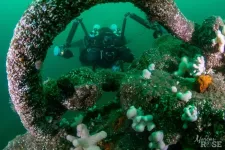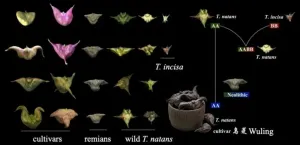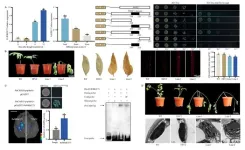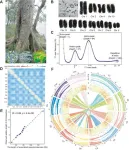(Press-News.org) Animal embryos go through a series of characteristic developmental stages on their journey from a fertilized egg cell to a functional organism. This biological process is largely genetically controlled and follows a similar pattern across different animal species. Yet, there are differences in the details – between individual species and even among embryos of the same species. For example, the tempo at which individual embryonic stages are passed through can vary. Such variations in embryonic development are considered an important driver of evolution, as they can lead to new characteristics, thus promoting evolutionary adaptations and biodiversity.
Studying the embryonic development of animals is therefore of great importance to better understand evolutionary mechanisms. But how can differences in embryonic development, such as the timing of developmental stages, be recorded objectively and efficiently? Researchers at the University of Konstanz led by systems biologist Patrick Müller are developing and using methods based on artificial intelligence (AI). In their current article in Nature Methods, they describe a novel approach that automatically captures the tempo of development processes and recognizes characteristic stages without human input – standardized and across species boundaries.
Every embryo is a little different
Our current knowledge of animal embryogenesis and individual developmental stages is based on studies in which embryos of different ages were observed under the microscope and described in detail. Thanks to this painstaking manual work, reference books with idealized depictions of individual embryonic stages are available for many animal species today. "However, embryos often do not look exactly the same under the microscope as they do in the schematic drawings. And the transitions between individual stages are not abrupt, but more gradual," explains Müller. Manually assigning an embryo to the various stages of development is therefore not trivial even for experts and a bit subjective.
What makes it even more difficult: Embryonic development does not always follow the expected timetable. "Various factors can influence the timing of embryonic development, such as temperature," explains Müller. The AI-supported method he and his colleagues developed is a substantial step forward. For a first application example, the researchers trained their Twin Network with more than 3 million images of zebrafish embryos that were developing healthily. They then used the resulting AI model to automatically determine the developmental age of other zebrafish embryos.
Objective, accurate and generalizable
The researchers were able to demonstrate that the AI is capable of identifying key steps in zebrafish embryogenesis and detecting individual stages of development fully automatically and without human input. In their study, the researchers used the AI system to compare the developmental stage of embryos and describe the temperature dependence of embryonic development in zebrafish. Although the AI was trained with images of normally developing embryos, it was also able to identify malformations that can occur spontaneously in a certain percentage of embryos or that may be triggered by environmental toxins.
In a final step, the researchers transferred the method to other animal species, such as sticklebacks or the worm Caenorhabditis elegans, which is evolutionarily quite distant from zebrafish. "Once the necessary image material is available, our Twin Network-based method can be used to analyze the embryonic development of various animal species in terms of time and stages. Even if no comparative data for the animal species exists, our system works in an objective, standardized way", Müller explains. The method therefore holds great potential for studying the development and evolution of previously uncharacterized animal species.
Key facts:
EMBARGOED UNTIL THURSDAY, 23 NOVEMBER 2023, 17:00 CET (16:00 LONDON TIME, 11:00 U.S. EASTERN TIME)
Original publication: N. Toulany, H. Morales-Navarrete, D. Čapek, J. Grathwohl, M. Ünalan & P. Müller (2023) Uncovering developmental time and tempo using deep learning. Nature Methods; doi: 10.1038/s41592-023-02083-8
Konstanz researchers develop AI model that objectively records characteristic stages and tempo of embryonic development in animals without human input
Open science: The authors have made the Twin-Network open source code and their research data available for free on GitHub and KonDATA.
Funding: European Research Council (ERC), German Research Foundation (DFG), Max Planck Society (MPG), European Molecular Biology Organization (EMBO), Interdisciplinary Graduate School of Medicine (IZKF) University of Tübingen, Blue Sky funding programme of the University of Konstanz
Note to editors:
You can download an image here:
Link: https://www.uni-konstanz.de/fileadmin/pi/fileserver/2023/embryonalentwicklung.jpg
Caption: Zebrafish embryos go through characteristic developmental stages, but even sibling embryos differ in the speed of these stages. Artificial intelligence can be used to calculate differences between embryos in terms of development tempo, characteristic developmental stages and structural differences.
Image: © Patrick Müller, Nikan Toulany
END
AI recognizes the tempo and stages of embryonic development
How can we reliably and objectively characterize the speed and various stages of embryonic development? With the help of artificial intelligence! Researchers at the University of Konstanz present an automated method.
2023-11-23
ELSE PRESS RELEASES FROM THIS DATE:
Potential new target and drug candidate for Barth syndrome
2023-11-23
In a Nature Metabolism paper published today, researchers from the University of Pittsburgh detail a potential new target and a small-molecule drug candidate for treating Barth syndrome, a rare, life-threatening and currently incurable genetic disease with devastating consequences.
Barth syndrome affects about 1 in every 300,000 to 400,000 babies born worldwide. Those with the condition have weak muscles and hearts and experience debilitating fatigue and recurrent infections.
Pitt researchers discovered that faulty mitochondria are at least partially to blame, and identified a molecular culprit that could be targeted to potentially reverse the disease course in the future.
In ...
New therapy can treat rare and hereditary diseases
2023-11-23
A lot of research has been done over many decades on diseases that are widespread in large parts of the population, such as cancer and heart disease. As a result, treatment methods have improved enormously thanks to long-term research efforts on diseases that affect many people.
However, there are many diseases that affect just a handful people. These diseases often fly under the radar and are far less researched. They include quite a few rare, hereditary diseases, such as DOOR syndrome, which is ...
Y-chromosome and its impact on digestive diseases
2023-11-23
A major breakthrough in human genetics has been achieved with the complete decoding of the human Y chromosome, opening up new avenues for research into digestive diseases. This milestone, along with advancements in third-generation sequencing technologies, is poised to revolutionize our understanding of the genetic underpinnings of digestive disorders and pave the way for more personalized and effective treatment strategies.
The Y chromosome, the smallest of the human chromosomes, has long been shrouded in mystery due to its complex repetitive structure. However, recent advancements in sequencing technologies have enabled researchers to unravel the intricate details of this genetic ...
Fractional COVID-19 booster vaccines produce similar immune response as full-doses
2023-11-23
Reducing the dose of a widely used COVID-19 booster vaccine produces a similar immune response in adults to a full-dose with fewer side effects, according to a new study.
The research, led by Murdoch Children's Research Institute (MCRI) and the National Centre for Communicable Diseases in Mongolia, found that a half dose of a Pfizer COVID-19 booster vaccine elicited a non-inferior immune response to a full dose in Mongolian adults who previously had AstraZeneca or Sinopharm COVID-19 shots. But it found half-dose boosting may be less effective in adults primed with the Sputnik V COVID-19 vaccine.
The research ...
Consolidator Grants: ERC unleashes €627 million in grants to fuel excellent research across Europe
2023-11-23
Iliana Ivanova, European Commissioner for Innovation, Research, Culture, Education and Youth, said: “I extend my heartfelt congratulations to all the brilliant researchers who have been selected for ERC Consolidator Grants. I'm especially thrilled to note the significant increase in the representation of women among the winners for the third consecutive year in this prestigious grant competition. This positive trend not only reflects the outstanding contributions of women researchers but also highlights the strides we are making towards a more inclusive and diverse scientific community.”
President of the European Research Council Prof. Maria Leptin said: “The new ...
A fifth higher: Tropical cyclones substantially raise the Social Cost of Carbon
2023-11-23
Extreme events like tropical cyclones have immediate impacts, but also long-term implications for societies. A new study published in the journal Nature Communications now finds: Accounting for the long-term impacts of these storms raises the global Social Cost of Carbon by more than 20 percent, compared to the estimates currently used for policy evaluations. This increase is mainly driven by the projected rise of tropical-cyclone damages to the major economies of India, USA, China, Taiwan, and Japan under global warming.
“Intense tropical cyclones have the power to slow down the economic development of a country for more than a decade, our analysis shows. With global warming, the share ...
Study reveals how shipwrecks are providing a refuge for marine life
2023-11-23
An estimated 50,000 shipwrecks can be found around the UK’s coastline and have been acting as a hidden refuge for fish, corals and other marine species in areas still open to destructive bottom towed fishing, a new study has shown.
Many of these wrecks have been lying on the seabed for well over a century, and have served as a deterrent to fishers who use bottom towed trawling to secure their catches.
As a result, while many areas of the seabed have been damaged significantly in areas of heavy fishing pressure, the ...
Pangenomic study of water caltrop — structural variations play a role in speciation and asymmetric subgenome evolution
2023-11-23
Rice, maize, and wheat provide more than half of the calories consumed by humans. The decrease in crop diversity poses a significant risk to global food security. Therefore, the utilization of orphan crops has become an effective approach to address food security crises. Nevertheless, in the face of rapid urban and rural modernization and the intensification of agricultural practices, the availability of wild and cultivated orphan crops is dwindling, with a noticeable disparity in their collection, preservation, ...
Professor Tao Jun's team at Yangzhou University analyses the molecular mechanism of PoWRKY71 in response to drought stress of Paeonia ostii
2023-11-23
Paeonia ostii is a widely grown woody crop with up to 40% α-linolenic acid in its seed oil, which is beneficial to human health. Drought is a major environmental factor limiting the popularisation of P. ostii in hilly and mountainous areas, which may affect plant growth or lead to plant death.WRKY is one of the largest families of transcription factors in plants, and plays an important role in plant response to drought stress. However, the molecular mechanism by which P. ostii WRKY transcription factors respond to drought stress is still unclear.
In September 2023, Horticulture ...
The Chinese team completed the genome assembly of Cornus wilsoniana
2023-11-23
Cornus wilsoniana (2n=22) is a common shrub in the northern temperate zone of China. It blooms white flowers in spring and produces purple-black berries in autumn. This tree has a unique mottled bark texture that makes it particularly eye-catching in winter, earning it the common name "ghost dogwood". Due to its peeling bark in winter, it is commonly known as "Guangpi tree" in China. The fruit of C. wilsoniana is rich in oil and can be used to extract edible oil. The oil content ...
LAST 30 PRESS RELEASES:
Nanoplastics have diet-dependent impacts on digestive system health
Brain neuron death occurs throughout life and increases with age, a natural human protein drug may halt neuron death in Alzheimer’s disease
SPIE and CLP announce the recipients of the 2025 Advanced Photonics Young Innovator Award
Lessons from the Caldor Fire’s Christmas Valley ‘Miracle’
Ant societies rose by trading individual protection for collective power
Research reveals how ancient viral DNA shapes early embryonic development
A molecular gatekeeper that controls protein synthesis
New ‘cloaking device’ concept to shield sensitive tech from magnetic fields
Researchers show impact of mountain building and climate change on alpine biodiversity
Study models the transition from Neanderthals to modern humans in Europe
University of Phoenix College of Doctoral Studies releases white paper on AI-driven skilling to reduce burnout and restore worker autonomy
AIs fail at the game of visual “telephone”
The levers for a sustainable food system
Potential changes in US homelessness by ending federal support for housing first programs
Vulnerability of large language models to prompt injection when providing medical advice
Researchers develop new system for high-energy-density, long-life, multi-electron transfer bromine-based flow batteries
Ending federal support for housing first programs could increase U.S. homelessness by 5% in one year, new JAMA study finds
New research uncovers molecular ‘safety switch’ shielding cancers from immune attack
Bacteria resisting viral infection can still sink carbon to ocean floor
Younger biological age may increase depression risk in older women during COVID-19
Bharat Innovates 2026 National Basecamp Showcases India’s Most Promising Deep-Tech Ventures
Here’s what determines whether your income level rises or falls
SCIE indexation achievement: Celebrate with Space: Science & Technology
Children’s Hospital Colorado performs region’s first pediatric heart and liver dual organ transplant
Australian team discover why quantum computers have memory problems over time
What determines the fate of a T cell?
Candida auris: genetic process revealed which could be treatment target for deadly fungal disease
Groundbreaking discovery turns household plastic recycling into anti-cancer medication
Blocking a key inflammatory pathway improves liver structure and vascular function in cirrhosis, study finds
Continuous spread: Raccoon roundworm detected in nine European countries
[Press-News.org] AI recognizes the tempo and stages of embryonic developmentHow can we reliably and objectively characterize the speed and various stages of embryonic development? With the help of artificial intelligence! Researchers at the University of Konstanz present an automated method.




